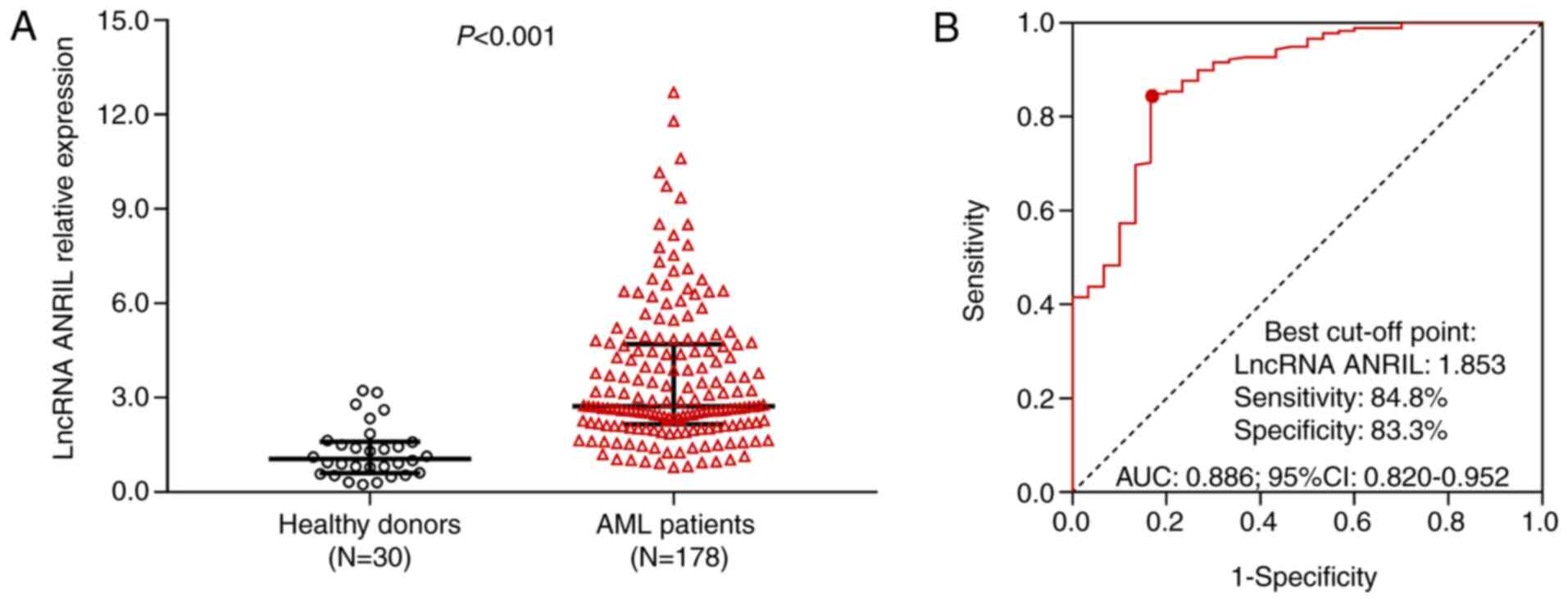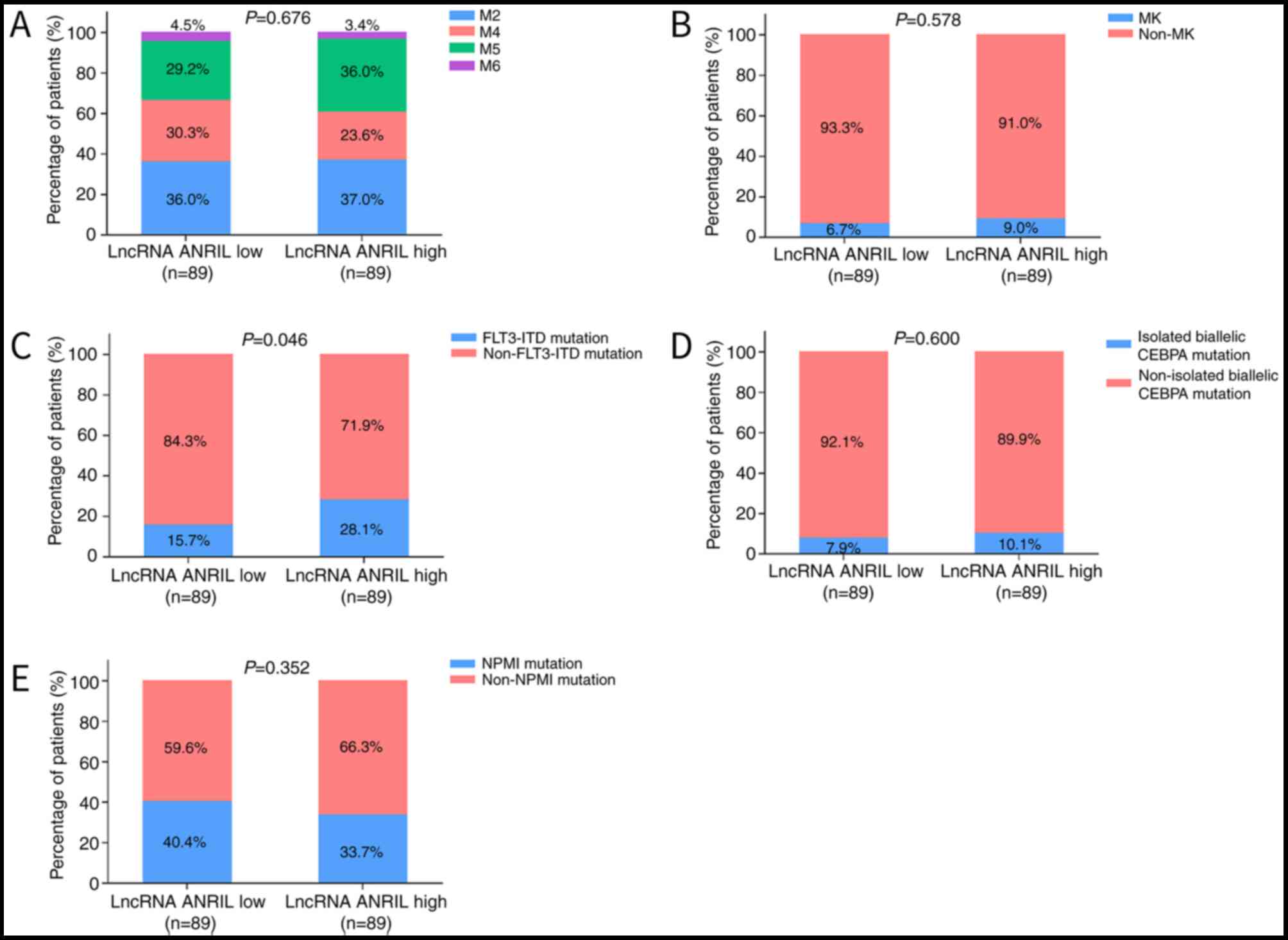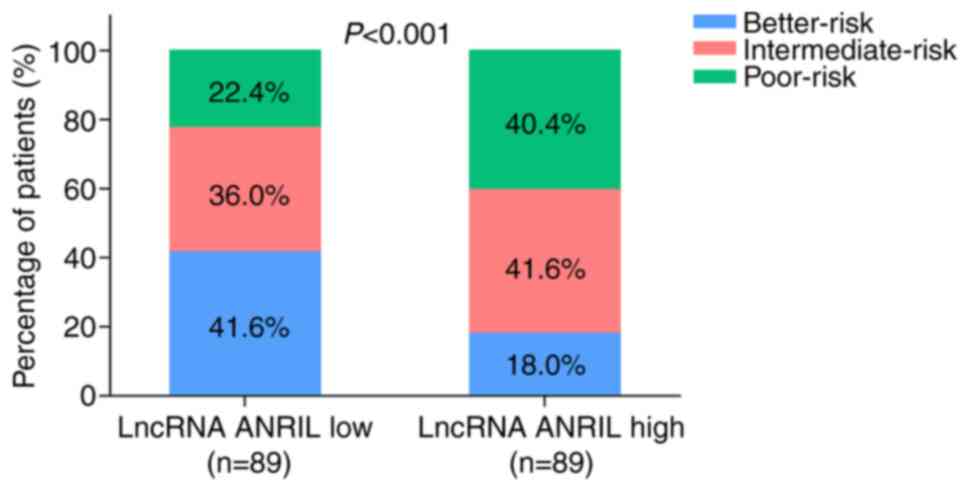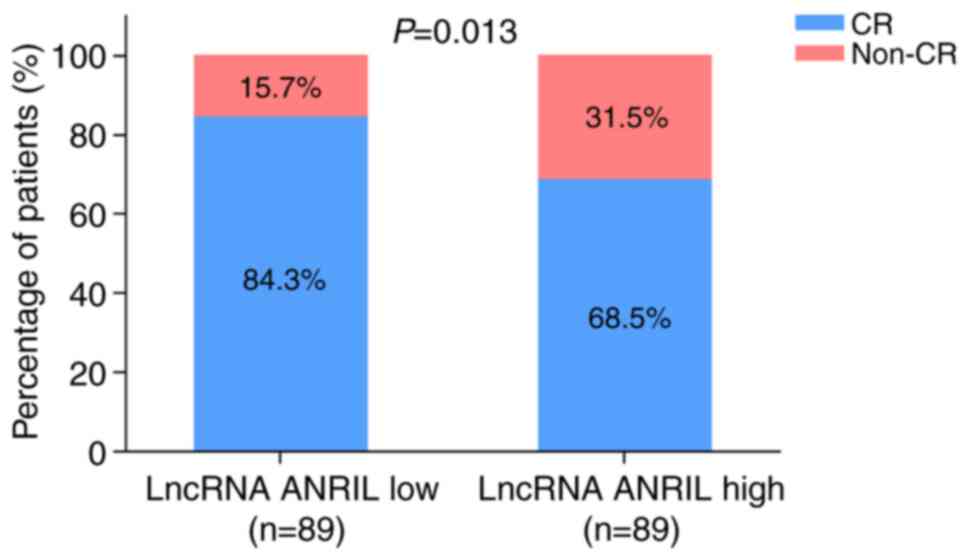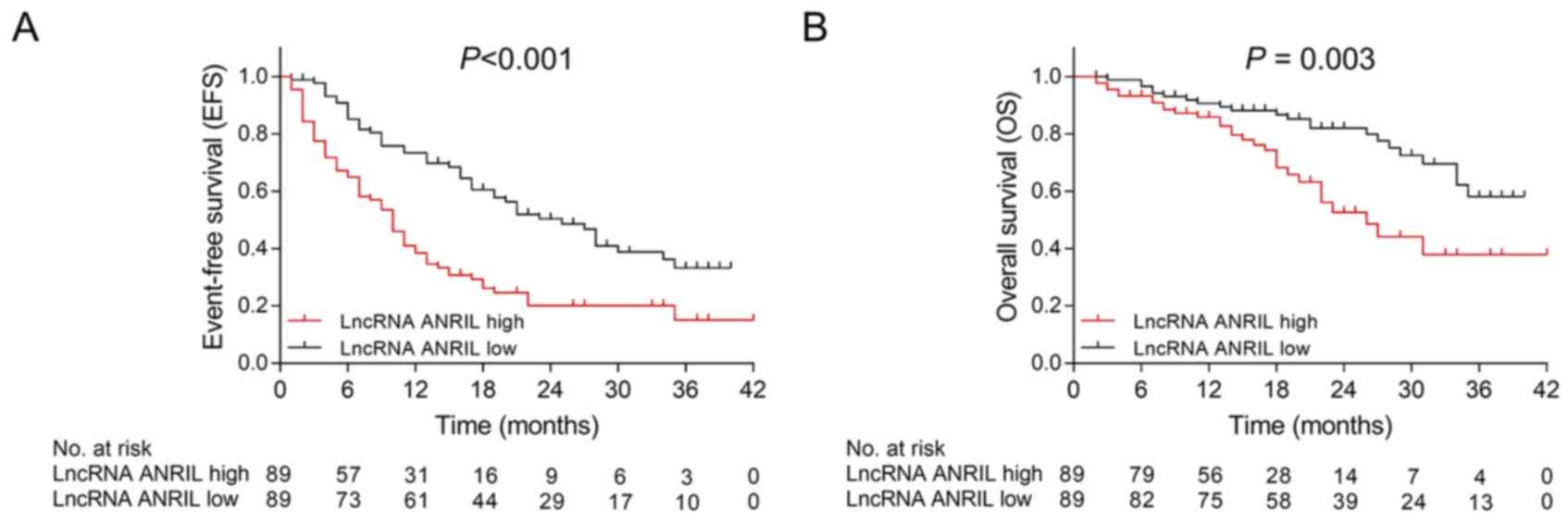|
1
|
Döhner H, Weisdorf DJ and Bloomfield CD:
Acute myeloid leukemia. N Engl J Med. 373:1136–1152. 2015.
View Article : Google Scholar : PubMed/NCBI
|
|
2
|
Prada-Arismendy J, Arroyave JC and
Röthlisberger S: Molecular biomarkers in acute myeloid leukemia.
Blood Rev. 31:63–76. 2017. View Article : Google Scholar : PubMed/NCBI
|
|
3
|
Zimta AA, Tomuleasa C, Sahnoune I, Calin
GA and Berindan-Neagoe I: Long non-coding RNAs in myeloid
malignancies. Front Oncol. 9:10482019. View Article : Google Scholar : PubMed/NCBI
|
|
4
|
Tallman MS, Gilliland DG and Rowe JM: Drug
therapy for acute myeloid leukemia. Blood. 106:1154–1163. 2005.
View Article : Google Scholar : PubMed/NCBI
|
|
5
|
Congrains A, Kamide K, Ohishi M and Rakugi
H: ANRIL: Molecular mechanisms and implications in human health.
Int J Mol Sci. 14:1278–1292. 2013. View Article : Google Scholar : PubMed/NCBI
|
|
6
|
Pasmant E, Laurendeau I, Hèron D, Vidaud
M, Vidaud D and Bièche I: Characterization of a germ-line deletion,
including the entire INK4/ARF locus, in a melanoma-neural system
tumor family: Identification of ANRIL, an antisense noncoding RNA
whose expression coclusters with ARF. Cancer Res. 67:3963–3969.
2007. View Article : Google Scholar : PubMed/NCBI
|
|
7
|
Hao YR, Zhang DJ, Fu ZM, Guo YY and Guan
GF: Long non-coding RNA ANRIL promotes proliferation,
clonogenicity, invasion and migration of laryngeal squamous cell
carcinoma by regulating miR-181a/Snai2 axis. Regen Ther.
11:282–289. 2019. View Article : Google Scholar : PubMed/NCBI
|
|
8
|
Ma Y, Zhang H, Li G, Hu J, Liu X and Lin
L: LncRNA ANRIL promotes cell growth, migration and invasion of
hepatocellular carcinoma cells via sponging miR-144. Anticancer
Drugs. 30:1013–1021. 2019. View Article : Google Scholar : PubMed/NCBI
|
|
9
|
Deng W, Zhang Y, Cai J, Zhang J, Liu X,
Yin J, Bai Z, Yao H and Zhang Z: LncRNA-ANRIL promotes gastric
cancer progression by enhancing NF-kB signaling. Exp Biol Med
(Maywood). 244:953–959. 2019. View Article : Google Scholar : PubMed/NCBI
|
|
10
|
Zhang LM, Ju HY, Wu YT, Guo W, Mao L, Ma
HL, Xia WY, Hu JZ and Ren GX: Long non-coding RNA ANRIL promotes
tumorgenesis through regulation of FGFR1 expression by sponging
miR-125a-3p in head and neck squamous cell carcinoma. Am J Cancer
Res. 8:2296–2310. 2018.PubMed/NCBI
|
|
11
|
Cao T, Shen J, Pan W, Li C and Qiao Z:
Upregulation of long noncoding RNA ANRIL correlates with tumor
progression and poor prognosis in esophageal squamous cell
carcinoma. J BUON. 23:1862–1866. 2018.PubMed/NCBI
|
|
12
|
Wang CH, Li QY, Nie L, Ma J, Yao CJ and
Chen FP: LncRNA ANRIL promotes cell proliferation, migration and
invasion during acute myeloid leukemia pathogenesis via negatively
regulating miR-34a. Int J Biochem Cell Biol. 119:1056662020.
View Article : Google Scholar : PubMed/NCBI
|
|
13
|
Sun LY, Li XJ, Sun YM, Huang W, Fang K,
Han C, Chen ZH, Luo XQ, Chen YQ and Wang WT: LncRNA ANRIL regulates
AML development through modulating the glucose metabolism pathway
of AdipoR1/AMPK/SIRT1. Mol Cancer. 17:1272018. View Article : Google Scholar : PubMed/NCBI
|
|
14
|
Jafie ES, Harris NL, Stein H and JW W:
Tumors of haematopoietic and lymphoid tissues. IARCPress; Lyon:
2001
|
|
15
|
Bennett JM, Catovsky D, Daniel MT,
Flandrin G, Galton DA, Gralnick HR and Sultan C: Proposed revised
criteria for the classification of acute myeloid leukemia. A report
of the French-American-British cooperative group. Ann Intern Med.
103:620–625. 1985. View Article : Google Scholar : PubMed/NCBI
|
|
16
|
National Comprehensive Cancer Network AML
Guidelines Version 2. 2014.
|
|
17
|
Livak KJ and Schmittgen TD: Analysis of
relative gene expression data using real-time quantitative PCR and
the 2(-Delta Delta C(T)) method. Methods. 25:402–408. 2001.
View Article : Google Scholar : PubMed/NCBI
|
|
18
|
Tallman MS, Wang ES, Altman JK, Appelbaum
FR, Bhatt VR, Bixby D, Coutre SE, De Lima M, Fathi AT, Fiorella M,
et al: Acute myeloid leukemia, version 3.2019, NCCN clinical
practice guidelines in oncology. J Natl Compr Canc Netw.
17:721–749. 2019. View Article : Google Scholar : PubMed/NCBI
|
|
19
|
Döhner H, Estey EH, Amadori S, Appelbaum
FR, Büchner T, Burnett AK, Dombret H, Fenaux P, Grimwade D, Larson
RA, et al: Diagnosis and management of acute myeloid leukemia in
adults: Recommendations from an international expert panel, on
behalf of the European leukemianet. Blood. 115:453–474. 2010.
View Article : Google Scholar : PubMed/NCBI
|
|
20
|
Jiang MC, Ni JJ, Cui WY, Wang BY and Zhuo
W: Emerging roles of lncRNA in cancer and therapeutic
opportunities. Am J Cancer Res. 9:1354–1366. 2019.PubMed/NCBI
|
|
21
|
Bhan A, Soleimani M and Mandal SS: Long
noncoding RNA and cancer: A new paradigm. Cancer Res. 77:3965–3981.
2017. View Article : Google Scholar : PubMed/NCBI
|
|
22
|
Xu ST, Xu JH, Zheng ZR, Zhao QQ, Zeng XS,
Cheng SX, Liang YH and Hu QF: Long non-coding RNA ANRIL promotes
carcinogenesis via sponging miR-199a in triple-negative breast
cancer. Biomed Pharmacother. 96:14–21. 2017. View Article : Google Scholar : PubMed/NCBI
|
|
23
|
Liu P, Zhang M, Niu Q, Zhang F, Yang Y and
Jiang X: Knockdown of long non-coding RNA ANRIL inhibits
tumorigenesis in human gastric cancer cells via
microRNA-99a-mediated down-regulation of BMI1. Braz J Med Biol Res.
51:e68392018. View Article : Google Scholar : PubMed/NCBI
|
|
24
|
Zhang Z, Feng L, Liu P and Duan W: ANRIL
promotes chemoresistance via disturbing expression of ABCC1 by
regulating the expression of Let-7a in colorectal cancer. Biosci
Rep. 38:BSR201806202018. View Article : Google Scholar : PubMed/NCBI
|
|
25
|
Tsapogas P, Mooney CJ, Brown G and Rolink
A: The cytokine Flt3-ligand in normal and malignant hematopoiesis.
Int J Mol Sci. 18:11152017. View Article : Google Scholar
|















